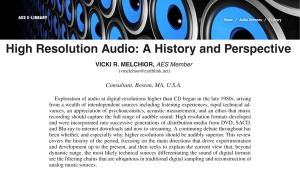| Columns Retired Columns & Blogs |
Conspiracy Theories
The criticisms are out there. They're in the audio newsgroups on the Internet, even in this magazine's "Letters" section. For years, Cassandras have proclaimed that Stereophile has sold out, gone down the tubes, become a mere lapdog for the big-league manufacturers whose components almost never get panned.
"There are too many positive reviews....Over time, [they] sound pretty much alike and don't differentiate one piece of gear from another well enough," one reader wrote. On the Internet, the postings are usually less cordial: "Stereophile is not a humanitarian effort. It is a business out to make a buck....Their business is based on advertising revenue..." There's no more objectivity, someone seconded: the magazine's "opinion is...tempered by industry politics."
Now that Stereophile has been sold to Petersen Publishing, whose stable includes highflying consumer magazines, some are shaking their heads I-told-you-so. An editor of another high-end magazine was clucking over the situation, as if his were (absolutely) the only one left with high-end credibility.
What we've got is a conspiracy theory. They're everywhere these days. Hillary Clinton claimed that her husband is being attacked by a "vast right-wing conspiracy." Newt, Trent, and the others, she implied, were secretly plotting behind closed doors, just like the shadowy power brokers depicted in The X-Files. Whatever conspirators are up to, it's bad. Our leaders in Santa Fe, the accusations go, are lining their pockets and charting a path toward consumer mediocrity, right on the heels of...[gasp!]...Stereo Review.
Conspiracy theories are seductive because they can't be proven false. They thrive in a murky logical terrain, somewhere between "not false" and "true." To their devotees, "not false" and "true" are the same. But they're not.
Here's a theory that can't be proven false, though only a fool would believe that it's true: Everything is five minutes old. That's it. It's a simple theory with huge implications. The big bang, the advent of life, your first kiss (or, if you wish, your first hearing of Quad ESLs)—never happened. What did happen all those years and centuries ago? Nothing. Time itself began five minutes ago. The universe popped into existence, complete with you and me, and its clockwork started ticking.
You may remember your first kiss all those years ago in vivid detail, but that only shows that images and feelings are contained somewhere in your neural circuitry. According to the theory, those memories are just five minutes old, too. Try as you may, no fact or memory or circumstance logically requires a believer to abandon this theory. For whatever you point to, the believer can reply that it came to be five minutes ago. The logic is unbeatable, just as the bumper sticker says: Just because you're paranoid doesn't mean everyone's not out to get you.
So there's no proof that Stereophile's editors and reviewers are not raking in the cash, or that John Atkinson and Wes Phillips don't take regular trips to Hawaii, all expenses paid. If they're not sporting tans, then the details don't matter. The negotiations and the payoffs, a conspiracy theorist will reason, must happen some other way. Good conspirators cover their tracks.
Besides the relaxed logic of conspiracy theories, some powerful emotions are fueling these indictments. Gregory Brylski wrote recently, "I'm really struck by how angry [some of] Stereophile's readers are." (October 1998, "Letters," p.12) So am I. Many who criticize the magazine seem downright bitter. What's gone wrong? In a community premised ultimately on music appreciation, why have so many become naysayers, finger-pointers, and conspiracy-sniffers?
Not too long ago, I stumbled on a stack of old Stereophiles from the 1970s, and I think I found the answer. It was amazing to see a very different world of high-end audio in those pages. Back then, the magazine was much smaller, and so was the industry. Companies have come and gone, and many of those that current subscribers would recognize had only recently emerged from basement workshops and garages. Most offered just one or two products—a speaker, or an amplifier.
I also learned better why this magazine's founder, J. Gordon Holt, is so revered. From 1962 through 1981, he produced the magazine largely by himself, and his distinctive, enthusiastic voice is on nearly every page. Sometimes he went over the top, as in Vol.4 No.4 in 1979—"Most musicians just don't care about reproduced sound"—and it's hard to imagine that readers took all of his advice to heart.
In the same issue, he praised the Hill Plasmatronic Speaker, whose tweeter was a ball of glowing, ionized gas. Don't worry, he reassured us, it shouldn't be too hard to find a local helium supplier to keep these contraptions burning away in your listening room. Can you imagine one of today's tony high-end salons displaying gorgeous, lacquered speakers that sit on the floor next to helium tanks?
The main attraction was J. Gordon's enthusiasm. If the Stereophile of the 1990s is a magazine, the Stereophile of the '70s was a fanzine. Issues varied in size and layout and sometimes appeared very late, leading J. Gordon to explain and apologize for the delays. Whenever they arrived in the mailbox, however, subscribers would get a dose of genuine audiophilia. As I turned those mildewy pages, I could just about see J. Gordon scrambling around putting each issue together—all for the love of audio.
Most important, J. Gordon practiced tough love. He was leading a crusade. The high-end industry was beginning to break away from its hobbyist roots and form an identity of its own. As much as a lone journalist/editor/publisher could, he fought constantly to improve equipment, to improve recording techniques, and to slay the what-you-measure-is-what-you-hear paradigm of High Fidelity and Stereo Review and Audio. And he did it really well:
- Log in or register to post comments




































